Canale L.C.F., Mesquita R.A., Totten G.E. Failure Analysis of Heat Treated Steel Components
Подождите немного. Документ загружается.

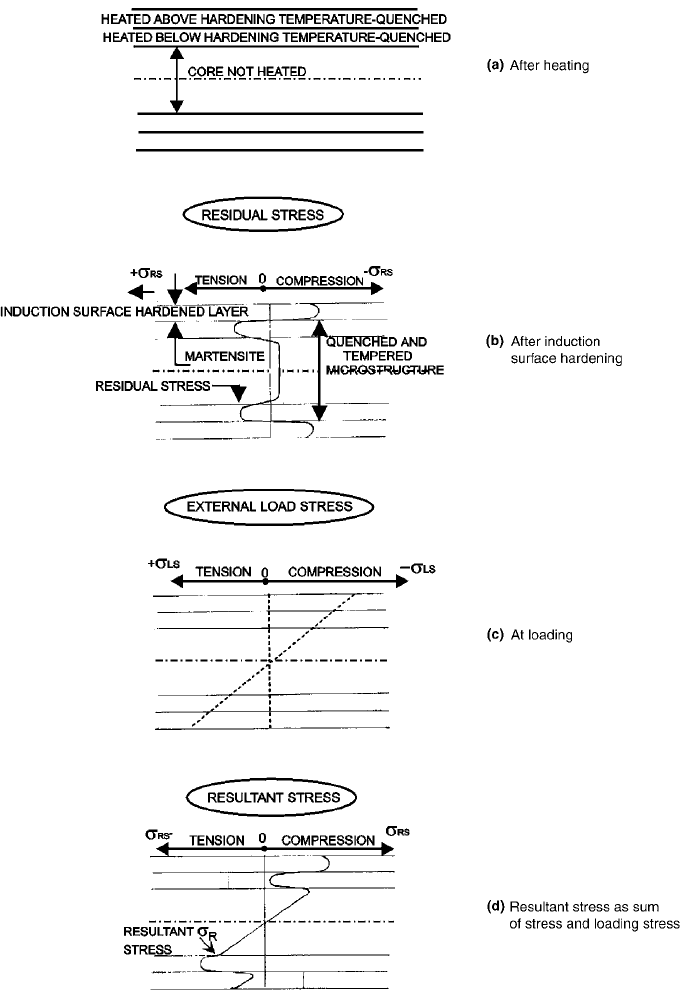
When a machine component that has been
surface induction hardened in this way is sub-
jected to an external load (Fig. 96c), additional
tensile residual stresses can be noted in the first
and second layers (Ref 15).
Since fatigue of a machine component is a
very delicate problem connected with the total
sum of tensile stresses in the second zone, there
is a danger that the effects of fatigue are trans-
ferred to the surface, due to the size, shape, and
Fig. 96
Stress profile in a round bar in the loaded state, where residual stresses after induction surface hardening and loading stresses
add up. Source: Ref 15
488 / Failure Analysis of Heat Treated Steel Components
Name ///sr-nova/Dclabs_wip/Failure_Analysis/5113_417-501.pdf/Chap_13/ 18/8/2008 4:03PM Plate # 0 pg 488
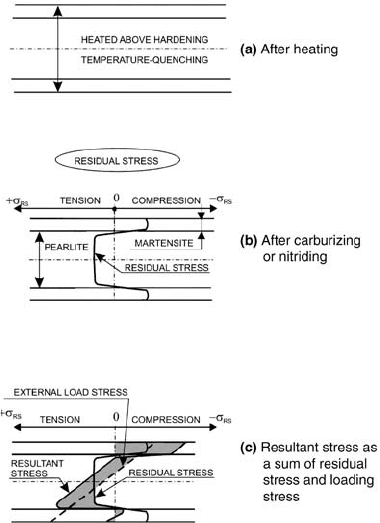
location of the hardened trace. When a loaded
layer is exposed to tensile external stress up to
the surface, the surface becomes very sensitive
to the occurrence of cracks (Fig. 96d) (Ref 15).
This propensity to cracking is further increased
if defects are present in the surface of the
workpiece material.
A critical state in the second zone of the hard-
ened surface layer occurs on locally hardened
workpieces, where the surface was overheated
or nonuniformly heated. The conditions are
quite the opposite in surface heating of work-
pieces, such as in nitriding and cementation
or intensive but shallow quenching of steel
(Fig. 97) (Ref 15). In these surface heat treat-
ment procedures, heating is carried out through-
out the whole machine component, followed by
slow cooling, for example, nitriding or quench-
ing such as in cementation. Residual stresses
in nitrided and cemented surface layers are
compressive, while tensile residual stresses
occur in the central part with the refined pearlite
microstructure.
The distribution of residual stresses in heat
treatment procedures where only the surface of
the workpiece is heated (induction hardening,
flame hardening) differs greatly from the pro-
cedures where heating is performed throughout
the entire volume (nitriding, cementation). In
nitriding and cementation, the aforementioned
second layer in the subsurface does not appear at
all, because the direction of the heat flow is
opposite to the direction of the heat flow in
induction and flame hardening. The resultant
operating tensile stresses on the surface or in the
surface layer can thus be considerably smaller.
Due to the hardness of the surface, induction and
flame hardening lowers the fatigue strength of
machine components. Therefore, care should be
taken to diminish all detrimental effects in the
surface layer.
A typical example of induction surface hard-
ening is surface hardening of gears that are
heated with a low heating rate and relatively low
current frequency. The outer hardened zone
includes almost the entire height of the gear
teeth, whereas the second zone is in the tooth
root area. A gear heat treated in this way will
meet the wear resistance requirements expected
of the gear tooth, while the strength of the other
part of the tooth is of minor importance. The
fatigue strength will be relatively low due to
high tensile residual stresses in the tooth root,
that is, in the second zone where the operating
or load tensions and the tensile residual stresses
are summed up. The energy input in heating a
gear tooth or the whole gear was such that
the second zone has not appeared. A similar
heat treatment can be applied to the spline inside
the gear. A gear heat treated in this way is
more resistant to wear and corrosion and should
have high resistance to fatigue in bending
because of a smaller thickness of the layer in the
second zone.
Residual Stresses in Carburized Machine
Parts. Carburizing is a process in which an
austenitized ferrous alloy is brought into contact
with an environment of sufficient carbon
potential to cause absorption of carbon at the
surface and, by diffusion, to create a carbon-
concentration gradient in the thin surface layer.
As this definition clearly indicates, two factors
may control carburizing. Either the carbon-
absorption reaction at the surface or the diffu-
sion of carbon in the steel will determine the
rate of carburizing. Carburizing is done at ele-
vated temperature, generally in the range of
850 to 950
C, although occasionally at tem-
peratures as low as 790
C and as high as
1095
C.
Fig. 97
Stress profile in a round bar in the loaded state, where
residual stresses after carburizing or nitriding and
loading stresses add up. Source: Ref 15
Induction Hardening / 489
Name ///sr-nova/Dclabs_wip/Failure_Analysis/5113_417-501.pdf/Chap_13/ 18/8/2008 4:04PM Plate # 0 pg 489

With the hardened steel, that is, hardened
machine part, the following was studied:
Effective case depth
Depth at which martensitic microstructure is
present
Hardness variation in the transition zone
between martensite and matrix
Microstructural composition in the transi-
tion zone with bainite-pearlite-ferrite
The characteristics obtained are essentially
affected by:
The grade, chemical composition, and
microstructure of steel in the soft state
The size, that is, mass, of the machine part
Considering that certain properties described
by the previously mentioned characteristics are
specified for the machine part, adequate condi-
tions for quenching from the austenitizing tem-
perature should be specified too. The quenching
conditions are described with reference to the
mass of the machine part.
Thus, in steel quenching, the following are
studied:
Volume, that is, dimensional changes due to
the differences in microstructure between
the initial material condition and the hard-
ened condition of the same material
Distortion of the machine part due to incor-
rect shaping of the machine part and/or an
improper quenching procedure
Residual stresses due to volume changes
occurring between the hardened zone and
unhardened zone of the machine part
Residual stresses may result from a defor-
mation of the machine part during the quenching
process. Internal forces due to temperature
stresses during quenching may exceed the yield
stress of the material, which results in plastic
deformation during the quenching process and
residual stresses after cooling. The magnitude of
residual stresses is related to the yield stress of
the material at the temperature at which the
deformation occurred.
Thus, in the case of through hardening in
which a complete and homogeneous austenitic
microstructure turns into a martensitic one, a 4%
volume change of the machine part or a 1.3%
linear increase in the machine-part size is
obtained:
DV
V
100=4%
In incomplete hardening, the volume changes at
the surface are greater than in the core, which
produces transformation strains. The residual-
stress variation thus depends on:
Quenching/cooling conditions
Temperature difference between the surface
and the core during the quenching process
Temperature interval between the beginning
and end of martensitic transformation and
the cooling rate in this zone
An image of the magnitude of internal stresses
during the quenching process can be provided by
a test of quenching cylindrical specimens from a
temperature lower than the transformation tem-
perature. During the quenching process, tem-
peratures are measured at the specimens, that is,
at their surface and in their core. Maximum
thermal stresses can thus be calculated (Ref 1,
20, 71, 72). The maximum thermal stresses
found in the cylindrical specimens with the
smallest diameter, 25 mm, and further specimen
diameters in a geometrical ratio with a factor of 2
are given in Table 5.
As an approximate orientation to the cooling
rates obtained, a calculation was made for a
temperature of 500
C. Comparative data on
maximum thermal stresses refer to air cooling
and oil quenching. With air cooling, the stresses
obtained in the specimen with the smallest dia-
meter, 25 mm, equal only 7 MPa, whereas for
the specimen with the largest diameter, 800 mm,
the stresses are as much as 200 MPa. The maxi-
mum thermal stresses, however, are con-
siderably higher with oil quenching; they range
between 230 MPa with the 25 mm diameter
specimen and 620 MPa with the 800 mm dia-
meter specimen. The latter represents an extre-
mely high internal thermal stress that may result
in material plastification. The data exclude
stresses due to phase changes and stresses due to
inhomogeneity, which additionally increase
their value.
Results of the measured residual stresses with
surface-hardened steels are given in Table 6.
The stresses were measured by the x-ray dif-
fraction technique just below the surface, that is,
0.05 mm. The results refer to steel grades
832M13, 805A20, 805A17, 897M39, 905M39,
and cold rolled steel after induction hardening,
with the longitudinal residual stresses being
measured. The values of longitudinal stresses
after carburizing to 1.0 to 1.5 mm case with
0.8% surface carbon and direct quenching
without tempering range between 190 and
490 / Failure Analysis of Heat Treated Steel Components
Name ///sr-nova/Dclabs_wip/Failure_Analysis/5113_417-501.pdf/Chap_13/ 18/8/2008 4:04PM Plate # 0 pg 490
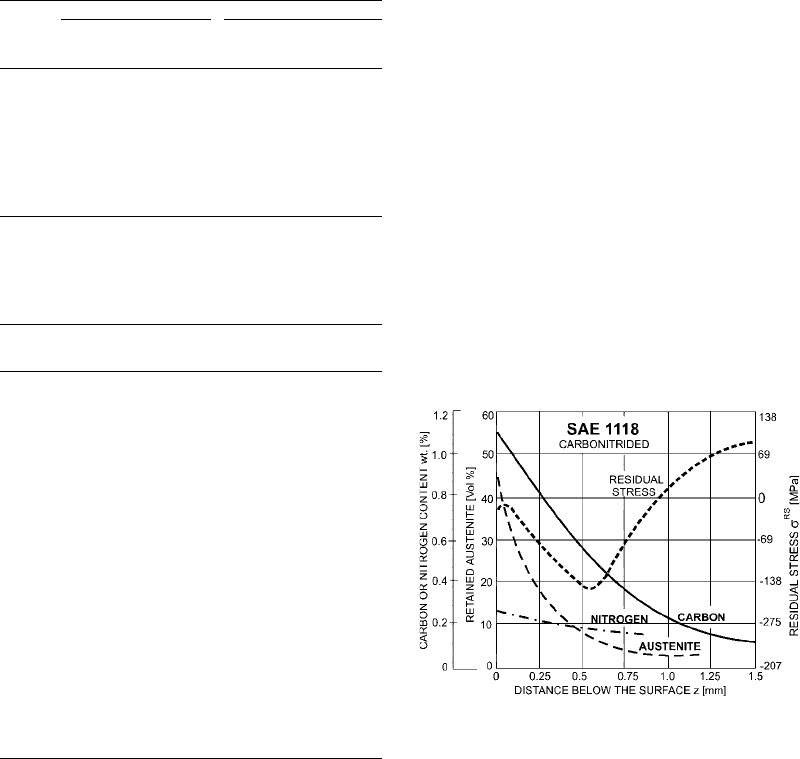
400 MPa, which depends on the steel grade
selected. With steel 832M13, testing of speci-
mens after quenching and by undercooling to
80 and 90
C with tempering and without
tempering was performed. Tempering con-
tributes to obtaining tempered martensite and
possible transformation of retained austenite,
which produces a reduction, that is, a compen-
sation, of the existing residual-stress profile.
Thus, the lowest residual stress is obtained in
steel quenching by undercooling and subsequent
tempering. In nitriding of steel 897M39 to a
depth of 0.5 mm, however, a residual stress
ranging between 400 and 600 MPa is obtained.
In steel 905M39, however, a considerably
higher residual stress, ranging between 800 and
1000 MPa, is obtained in nitriding to the same
depth. The highest residual stresses were mea-
sured in cold-rolled steel subjected to additional
induction surface hardening without tempering.
A maximum value obtained was 1000 MPa.
With additional tempering at 200
C, martensite
will become tempered and the residual stresses
reduced to 650 MPa. By additional tempering at
an even higher temperature, at which martensite
disintegrates, the maximum measured stresses
decrease. For example, at a tempering tem-
perature of 400
C, they decrease to 170 MPa or
a factor of 6 lower than those obtained imme-
diately after steel quenching.
Figure 98 shows the results of carbonitriding
SAE 1118 steel with reference to the contents of
carbon and nitrogen at the surface and the gra-
dient of the two in the subsurface (Ref 71). The
austenite content, that is, the austenite gradient
of the two in the subsurface, and the way a
complementary residual-stress variation pro-
ceeds in the subsurface are very important.
With a gradual reduction of austenite content
to a depth of 0.5 mm, the residual stresses
decrease as well, and the maximum pressure
achieved is 200 MPa. To a depth of 45 mm,
the stresses gradually increase to tensile values,
and at a depth of 1.5 mm, they are as much as
+100 MPa.
Input and Output Control of Steel for
Induction Surface Hardening of Gears
Production automation necessitates an ever-
increasing demand for greater uniformity of the
Table 6 Residual stresses measured in surface
heat treated steels
Steel Heat treatment
Residual stress
(longitudinal),
MPa
832M13 Carburized at 970
C to 1.0 mm
case with 0.8% surface carbon
280
Direct quenched, 80
C subzero
treatment, no temper
340
Direct quenched, 90
C subzero
treatment, tempered
200
805A20 Carburized and quenched 240–340(a)
805A20
Carburized to 1.1–1.5 mm case
at 920
C, direct oil quench,
no temper
190–230
805A17 400
805A17 Carburized to 1.1–1.5 mm case
at 920
C, direct oil quench,
tempered at 150
C
150–200
897M39
Nitrided to case depth of
approximately 0.5 mm
400–600
905M39 800–1000
Cold
rolled
steel
Induction hardened, untempered 1000
Induction hardened, tempered
at 200
C
650
Induction hardened, tempered at
300
C
350
Induction hardened, tempered at
400
C
170
(a) Immediately subsurface, that is, 0.05 mm. Source: Ref 71
Table 5 Cooling rate thermal stresses in simple
rounds with no transformation
Diameter
of round
(D), mm
Air cooled Oil quenched
Cooling rate
at 500 °C
(v
500
), °C/s
Maximum
thermal stress
s
TH
max
, MPa
Cooling
rate at 500 °C
(v
500
), °C/s
Maximum
thermal stress
s
TH
max
, MPa
25 0.662 7 20.0 230
50 0.312 15 6.12 290
100 0.146 28 1.88 370
200 0.070 54 0.59 450
300 0.0445 73 0.29 510
400 0.0326 100 ... (540)
800 0.0158 200 ... (620)
Source: Ref 1, 71
Fig. 98
Residual stress, carbon, nitrogen, and retained aus-
tenite through a carbonitrided case on SAE 1118
steel. Source: Ref 71
Induction Hardening / 491
Name ///sr-nova/Dclabs_wip/Failure_Analysis/5113_417-501.pdf/Chap_13/ 18/8/2008 4:04PM Plate # 0 pg 491
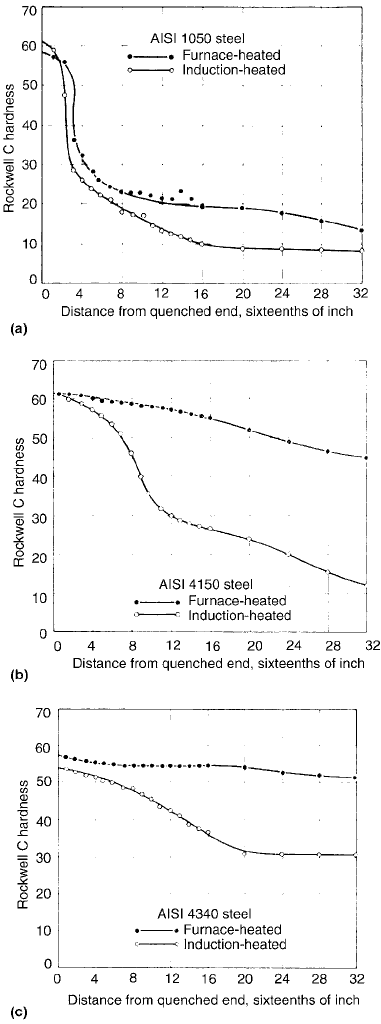
properties of heat treated steel parts (Ref 73).
Therefore, a general market demand is for a
certain prescribed quality that is usually the
result of various properties (Ref 41, 74–82). One
of the most important properties is hard-
enability, which should be a uniform and con-
stant property of steel regardless of the treatment
conditions in the ironworks. In the experimental
part of the study, the starting point was the
analysis of steel hardenability according to the
Jominy test (Ref 40, 74–76). On this basis, the
conditions for induction hardening were pre-
scribed for a worm gear tooth. The success of the
induction hardening was verified by the micro-
hardness measurement along the tooth profile
centerline (Ref 83, 84).
Figure 99 shows Jominy curves for the hard-
ness profiles of the specimen front of AISI 1050,
4150, and 4340 steels (Ref 40, 41). It generally
applies that Jominy curves for common test-
specimen heating differ strongly from those for
the specimens induction heated and quenched in
the same way. Hardness differences in the
Jominy test specimen are minimal at the surface
and increase through the depth. It is important
that the hardness profiles of the furnace-heated
test specimens or short-term induction-heated
specimens differ less if carbon steels have a
smaller carbon content (AISI 1050) and differ
more strongly with alloyed steel, as was the case.
Figure 100 shows Jominy curves for furnace
heating and induction heating. Both figures
indicate that the through-height hardness profile
of a Jominy specimen depends on the maximum
temperature obtained at the surface (Fig. 100b)
and on heating time (Fig. 100a), the power
density being given (Ref 40, 41). Induction
heating was performed under the conditions
given and with different heating times. Furnace
heating of Jominy specimens at 870
C provides
the highest hardness values for the hardened
front.
In induction heating at the same temperature,
870
C, a quite different hardness profile of the
Jominy specimen hardened front is obtained
(Fig. 100a). With an increasing surface auste-
nitizing temperature, the through-height hard-
ness profile of the specimen increases so that at a
temperature of 1040
C, there is negligible dif-
ference in the hardness profile of the Jominy
specimen, regardless whether it was furnace
heated or induction heated.
The prescription for the verification of the
effects of induction hardening was carried out
for the upper- and lower-limit microhardness
from the tooth top and to a depth of
9
/
6
of the
tooth height. The experiments on heat treatable
carbon steel C35 with a different history have
Fig. 99
Jominy curves for end-quenched bars of (a) AISI
1050, (b) 4150, and (c) 4340 steels, austenitized
conventionally and by short-time induction heating. Source: Ref
40, 41
492 / Failure Analysis of Heat Treated Steel Components
Name ///sr-nova/Dclabs_wip/Failure_Analysis/5113_417-501.pdf/Chap_13/ 18/8/2008 4:04PM Plate # 0 pg 492
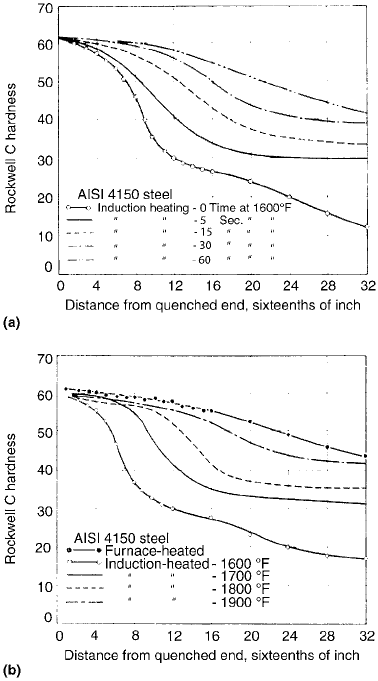
shown that with the existing heat treatment con-
ditions, it is not possible to achieve the micro-
hardness profile required by the user (Ref 79).
First, it was necessary to find a Slovenian
substitute for the French steel CC35. This was
done with the help of a cooperative industry.
Steel CC35 is a heat treatable steel that has been
mechanically machined and induction hardened
to ensure a uniform quality.
Steel C35, chosen as a substitute, is classified
among the high-grade, unalloyed, heat treatable
carbon steels with a maximum phosphorus and
sulfur content lower than 0.035%. It is intended
for parts smaller than 100 mm, subjected to
lower loads, and with high requirements on
homogeneity of material after heat treatment
and mechanical machining.
For the selected heat treatable carbon steel
C35, a suitable acceptance control procedure
had to be prescribed, with special emphasis on
hardenability.
Based on the corresponding criteria, the
acceptance conditions should enable the classi-
fication of steels into quality classes in accor-
dance with the different heat treatment
prescriptions. The chemical composition of the
steel is presented according to International
Organization for Standardization (ISO) stan-
dards and that of the French according to the
Association Francaise de Normalisation
(AFNOR). The chemical composition is given
by quoting the upper and lower content limit for
each particular part. The limits of the Slovenian
steel are much more constrained than that of the
French. In the French steel, there is a higher
content of carbon, manganese, and traces of
chromium, which leads to somewhat better
hardenability compared to the Slovenian steel
C35.
Figure 101 presents the hardness curves of the
Jominy specimen versus the distance from the
face (Ref 83). The starting point for the analysis
was the upper and lower confidence limit for
Slovenian steel C35 as prescribed by the pro-
ducer, Ravne Ironworks.
The given confidence limits are presented by
the hatched area on the extreme right of the
figure. Since testing enables a successful selec-
tion of steel as well as optimal heat treatment
conditions, it was decided to test the upper and
lower confidence limits of a small-sized, hard-
ened worm gear (Fig. 102a) (Ref 83). This gear
must have hard, wear-resistant surfaces and an
increased strength due to loading conditions or
expected load-carrying capacity of the teeth.
Both of these properties are achieved by induc-
tion hardening. The success of the heat treatment
was verified by Vickers microhardness mea-
surements at a loading of 0.3 daN acting along
the centerline of the tooth profile. The verifica-
tion of the effects of surface hardening and
simultaneous heat treatment of the teeth was
carried out in ten measurements: the first on the
tooth top and then each subsequent measure-
ment at a distance of
1
/
6
h or 0.367 mm. Thus,
in ten measurements the microhardness was
measured down to the depth of
9
/
6
of the tooth
height, as shown in Fig. 102(b) (Ref 83). When
ordering the gear, the customer specified
the prescribed allowable hardness for forming
the upper and lower confidence limits along the
height of the gear tooth.
Fig. 100
Effect of (a) time at an 870
C austenitizing tem-
perature and (b) maximum surface temperature
on the Jominy curves for induction-hardened AISI 4150 steel.
The curve for conventional furnace-heated 4150 is also shown
in (b). Source: Ref 40, 41
Induction Hardening / 493
Name ///sr-nova/Dclabs_wip/Failure_Analysis/5113_417-501.pdf/Chap_13/ 18/8/2008 4:04PM Plate # 0 pg 493
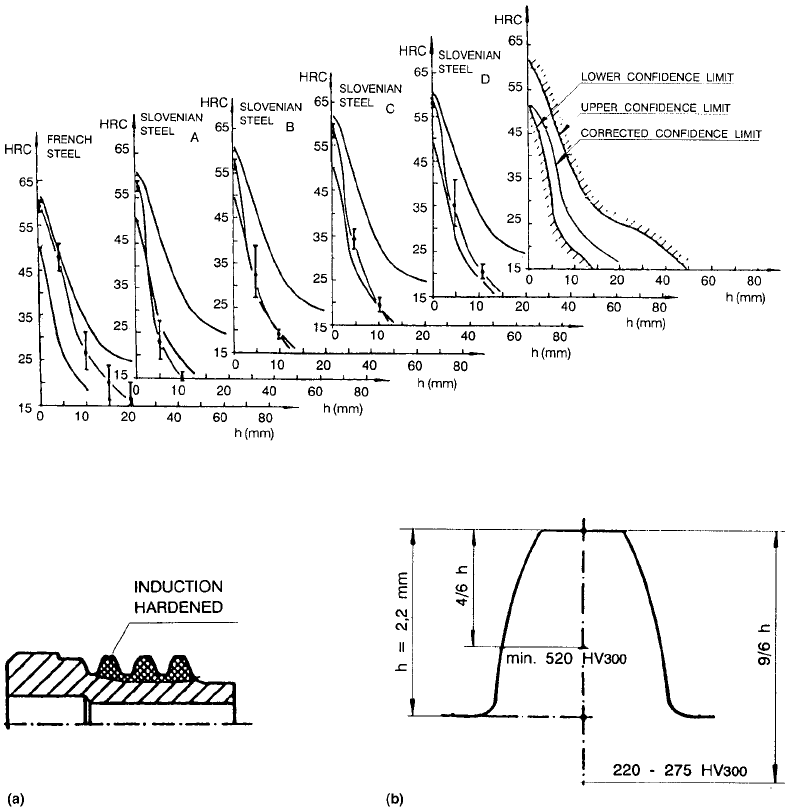
The microhardness limit values were:
On the tooth top at h = 0, the microhardness
is 680 to 800 HV
0.3
.
In the depth of
4
/
6
h or 1.45 mm, the micro-
hardness is 520 HV
0.3
maximum.
In the depth of
8
/
6
h or 2.90 mm, the micro-
hardness is 520 HV
0.3
maximum.
In the depth of
9
/
6
h or 3.30 mm, the micro-
hardness is 220 to 275 HV
0.3
.
On the basis of hardenability testing, the fol-
lowing conclusions can be drawn:
Due to a higher content of carbon, manga-
nese, and some traces of chromium, the
French steel CC35 displays a very favorable
hardenability according to the Jominy tests.
Even to a depth of 7 mm, the hardenability
curve shows 40 HRC, then hardness begins to
decrease rapidly and, at a depth of 10 mm, is
only 22 HRC.
The Slovenian steel C35 produced by the
Ravne Ironworks has a slightly lower con-
tent of carbon and a considerably lower
content of manganese. For example, for steel
of charge “B”, the carbon content is lower by
0.06% and the manganese content by 0.35%,
according to the French steel. On the basis of
the data in the literature, it was determined
that this considerably lower manganese
Fig. 101 Hardenability of the analyzed steels and determination of the upper and lower confidence limit. Source: Ref 83
Fig. 102 Worm characteristics after induction surface hardening. Source: Ref 83
494 / Failure Analysis of Heat Treated Steel Components
Name ///sr-nova/Dclabs_wip/Failure_Analysis/5113_417-501.pdf/Chap_13/ 18/8/2008 4:04PM Plate # 0 pg 494
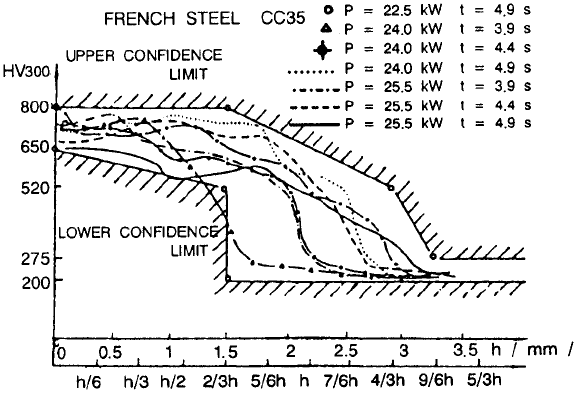
content reduces the effect of hardenability
by a factor of 1.5. The relative effect of
silicon on hardenability is practically negli-
gible, although the content may vary within
0.1 to 0.4%.
The results of the hardenability testing of the
discussed steels are presented in Fig. 101 (Ref
83). Based on the mean values and their devia-
tions, it was determined that the curve of hard-
enability or hardness shows solid progress into
the depth in the French steel CC35 and steel C35
of charge “C” and “D”. On the other side, the
hardenability of Slovenian steel C35 of charge
“C” and “D” is much lower, so that at a depth of
4 to 5 mm, the lower confidence limit is excee-
ded. The input control of steel should be focused
mainly on the lower confidence limit of hard-
enability, because the progress of hardness has a
decisive influence on the strength properties of
the gear teeth. It was determined that the upper
confidence limit corresponds to the maximum
hardness achieved, and that it cannot be ex-
ceeded in any way. It was therefore decided that
the place of the corrected lower confidence limit
would be defined using Jominy hardenability
tests, determining the actual progress of hard-
ness. As a criterion for the correction of the
lower confidence limit, the microhardness along
the tooth height (
9
/
6
h), limited by the maximum
and minimum microhardness, was used. This
helped to establish the primary criteria con-
ditioning the microhardness distribution on the
product, which was also limited by the upper and
lower confidence limit. The answer to which
charges of the steel are more suitable for use can
be obtained by associating the corresponding
microhardness confidence limits on the product
and also on the Jominy specimen. The desired
product characteristics were defined on the basis
of the following conditions of induction hard-
ening:
Generator power—22.5, 24.0 and 25.5 kW
Heating time—3.9, 4.4, and 4.9 s
Time/pause between the end of heating and
the beginning of quenching—0.1 s
Quenching time—4.0 s
The results of induction hardening on the gear
are presented in Fig. 103 for the French steel
CC35 (Ref 83), and in Fig. 104 for the Slovenian
steel C35 at the given power values of a high-
frequency generator and heating times (Ref 83).
The diagrams show the upper and the lower
confidence limits for microhardness along the
tooth height. The results of microhardness dis-
tribution along the tooth height must fall within
the mentioned limits. However, it can be seen
that it is possible to reach only a lower micro-
hardness on the tooth that results from a lower
hardenability of the steel or from unsuitable heat
treatment conditions. The lower confidence
limit is defined only by the microhardness of the
basic material at a depth of
4
/
6
to
9
/
6
h and
represents only a theoretical limit. The data on
Fig. 103 Hardness distribution along the tooth symmetry line after heat treatment of the French steel CC35. Source: Ref 83
Induction Hardening / 495
Name ///sr-nova/Dclabs_wip/Failure_Analysis/5113_417-501.pdf/Chap_13/ 18/8/2008 4:04PM Plate # 0 pg 495
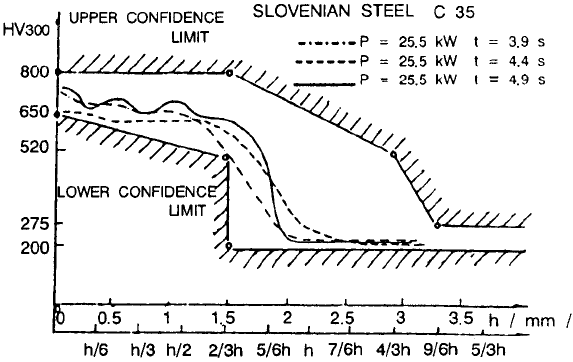
the steel properties and heat treatment condi-
tions provide various actual measured micro-
hardness distributions, where the microhardness
of the basic material is reached in the depth from
h to
9
/
6
h in the French steel CC35 and from
11
/
12
h to h in the Slovenian steel C35. From all these
data, it can be stated that it is possible, with
adequate heating and quenching conditions and
adequate hardenability, to reach the desired
microhardness distribution in the tooth. From
Fig. 103, it can be noted that in the case of the
French steel CC35 only three out of nine heat
treatment conditions fall out of the confidence
limit at the minimum power P = 22.5 kW (Ref
83). Quite the contrary can be found from
Fig. 104 presenting Slovenian steel C35. Here,
a desirable distribution of microhardness
along the tooth height was achieved only in
the conditions of maximum power (Ref 83). This
means that for an equal efficiency of induction-
hardened gears from the French steel CC35, a
significantly shorter heating time is necessary
than with steel C35. This time is estimated to be
for even a second shorter and represents a 25%
shorter heat treatment cycle, contributing to
lower costs of manufacturing.
Induction surface hardening of machine
components and especially gears is a very
complex process involving a whole range of
possible heat treatment methods, which are all
reflected in either good or bad serviceability of
machine components. The heat treatment engi-
neer must be aware of the different effects of
particular design shapes of induction coils, be
familiar with electromagnetic phenomena and
eddy currents, and have some experience in the
right choice of energy inputs necessary for
heating. The energy needed for heating can be
provided by changing the generator power as
well as the frequency of the current. In pro-
gressive hardening, to achieve a suitable energy
input, the workpiece feed rate or the rate at
which the coil is moved must be adjusted,
whereas in single-shot hardening, suitable
energy input is achieved by adjusting the heating
time with a high-frequency current. An essential
advantage of induction surface hardening is that
it is possible to achieve a sufficient repeatability
of the hardened layer thickness on the workpiece
as well as a desirable or even prescribed hard-
ened-layer profile, ensuring sufficient hardness
and favorable distribution of residual stresses in
the hardened layer. A variety of steels and a
whole range of induction-hardening methods
provide the possibilities for very accurate plan-
ning of the size and distribution of residual
stresses. This is of growing importance, since
manufacturers are frequently required to pro-
duce machine components that, among other
surface properties, must possess quite specific
residual-stress distribution along the depth of the
hardened layer. It has become a proven fact that
high compressive stresses ensure high fatigue
strength of machine components and reduce the
danger of the occurrence and growth of cracks
on the surface of components. As far as induc-
tion surface hardening is concerned, it is also
quite important to choose the right quenching
Fig. 104 Hardness distribution alon g the tooth symmetry line after heat treatment of the Slovenian steel C35. Source: Ref 83
496 / Failure Analysis of Heat Treated Steel Components
Name ///sr-nova/Dclabs_wip/Failure_Analysis/5113_417-501.pdf/Chap_13/ 18/8/2008 4:04PM Plate # 0 pg 496
medium and method of quenching. For this
reason, engineers must direct their attention not
only to the method of heating and possible
overheating of the surface layer but also to the
methods of quenching and the right choice of the
medium for quenching.
With increasing surface heating power in
the final phase, an increase in microhardness
along the tooth symmetry line is also reached,
especially in the depth from 0.5 to 2.5 mm,
whereas by making the heating time longer, a
more pronounced effect directed into the depth
can be achieved. In this way, an adequate heat
treatment can ensure the required surface hard-
ness (52 HRC) as well as an increased strength of
the gear in the tooth-root part, which is of
extreme importance for certain operating con-
ditions.
Tests have shown that it is necessary to move
the lower hardenability limit at least on the level
indicated by the scattered microhardness values
of the French steel CC35. The new lower con-
fidence limit is named the corrected limit,
ensuring the prescribed microhardness dis-
tribution in the subsurface at a power P =
24.0 kW and P = 25.5 kW.
On the basis of the tests, it can be concluded
that the criterion of hardenability can be very
successfully applied in the input control of
steels. Hardness decreases with the distance
from the face of the Jominy specimen and must
fall within the confidence limits. In some cases,
that is, with Slovenian steel C35 of charge “A”
and “B”, when the hardenability exceeds the
lower confidence limit, an adequate selection of
induction-hardening conditions (power in kilo-
watts and heating time in seconds) can ensure
the desired microhardness along the tooth sym-
metry line. The results confirm that heat treat-
ment conditions can be successfully determined
by relatively simple experiments that also make
the procedure more economical.
REFERENCES
1. H.C. Child, Surface Hardening of Steel,
Engineering Design Guides 37, Published
for the Design Council, The British Stan-
dards Institution and the Council of Engi-
neering Institutions, Oxford University
Press, Oxford, U.K., 1980
2. P.A. Hassell and N.V. Ross, Induction Heat
Treating of Steel, Heat Treating, Vol 4,
ASM Handbook, ASM International, 1991,
p 164–202
3. R.E. Haimbaugh, Practical Induction Heat
Treating, ASM International, 2001
4. S. Lampman, Introduction to Surface
Hardening of Steels, Heat Treating, Vol 4,
ASM Handbook, ASM International, 1991,
p 264–265
5. T. Ruglic, Flame Hardening of Steels, Heat
Treating, Vol 4, ASM Handbook, ASM
International, 1991, p 268
6. K. Sridhar and A.S. Khanna, Laser Surface
Heat Treatment, Chapter 3, Lasers in
Surface Engineering, N.B. Dahotre, Ed.,
Surface Engineering Series, Vol 1, ASM
International, 1998, p 69–70
7. J. Grum and R. S
ˇ
turm, Characteristics of
Laser Surface Melt-Hardening and of
Optimizing the Process, Second Int. Conf.
on Quenching and the Control of Distortion
(Cleveland, OH), 1996, p 193–200
8. J. Grum and R. S
ˇ
turm, Properties of Laser
Surface Melt Hardening on Cast Iron,
Proceedings of the Sixth European Con-
ference on Laser Treatment on Materials,
ECLAT’96 (Stuttgart, Germany), 1996,
p 501–508
9. J. Grum and P. Z
ˇ
erovnik, Residual Stresses
in Laser Heat Treatment of Plane Surface,
Proc. of the First Int. Conf. on Quenching
and Control of Distortion (Chicago, IL),
1992, p 333–341
10. O.A. Sandven, Laser Surface Hardening,
Heat Treating, Vol 4, ASM Handbook,
ASM International, 1991, p 286
11. D. Bialod, Ed., Electromagnetic Induction
and Electric Conduction in Industry, Centre
Francais de L’Electricite, Diffusion: CFE
and TEC and DOC, Paris, 1997
12. S. Schiller, S. Panzer, and B. Furchheim,
Electron Beam Surface Hardening of Steels,
Heat Treating, Vol 4, ASM Handbook,
ASM International, 1991, p 297
13. K.E. Thelning, Chapter 6.7: Flame Hard-
ening, Steel and Its Heat Treatment, Bofors
Handbook, Butterworth, London and
Boston, 1975, p 451–465
14. K.E. Thelning, Chapter 6.6.2: Steel Grades
for Induction Hardening, Steel and Its Heat
Treating, Bofors Handbook, Butterworth,
London and Boston, 1975, p 434–435
15. J. Grum, Induction Hardening, Materials
Science and Technology Series, Vol 1,
Faculty of Mechanical Engineering,
Ljubljana, 2001
Induction Hardening / 497
Name ///sr-nova/Dclabs_wip/Failure_Analysis/5113_417-501.pdf/Chap_13/ 18/8/2008 4:04PM Plate # 0 pg 497
